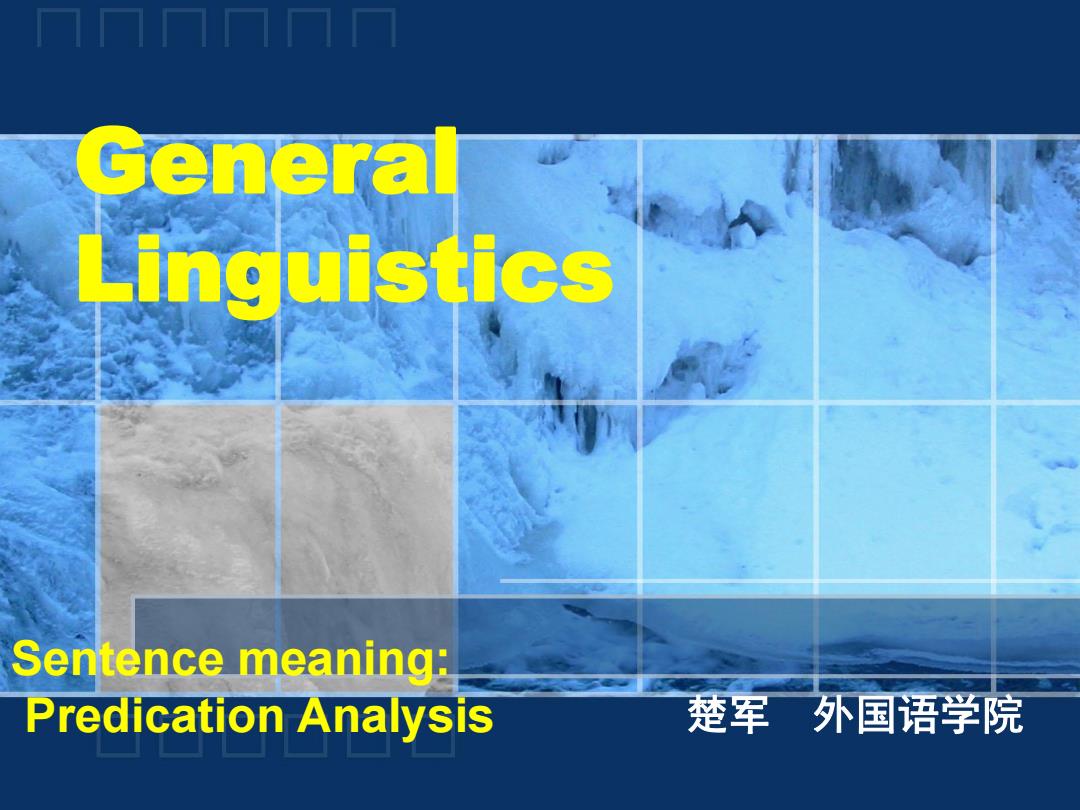
General Linguistics Sentence meaning: Predication Analysis 楚军外国语学院
Sentence meaning: Predication Analysis 楚军 外国语学院 General Linguistics

The Semantic Structure of Sentences How about this hypothesis? --the meaning of a sentence is merely the sum of the meanings of the words and other constituents which compose it. Without 'predication analysis',we could not tell the difference of meaning between: My wife has a new dog. My new wife has a dog. My new dog has a wife. (All these would have to be regarded as synonymous with the help of 'CA'.)
The Semantic Structure of Sentences How about this hypothesis? --the meaning of a sentence is merely the sum of the meanings of the words and other constituents which compose it. Without ‘predication analysis’ , we could not tell the difference of meaning between: My wife has a new dog. My new wife has a dog. My new dog has a wife. (All these would have to be regarded as synonymous with the help of ‘CA’.)
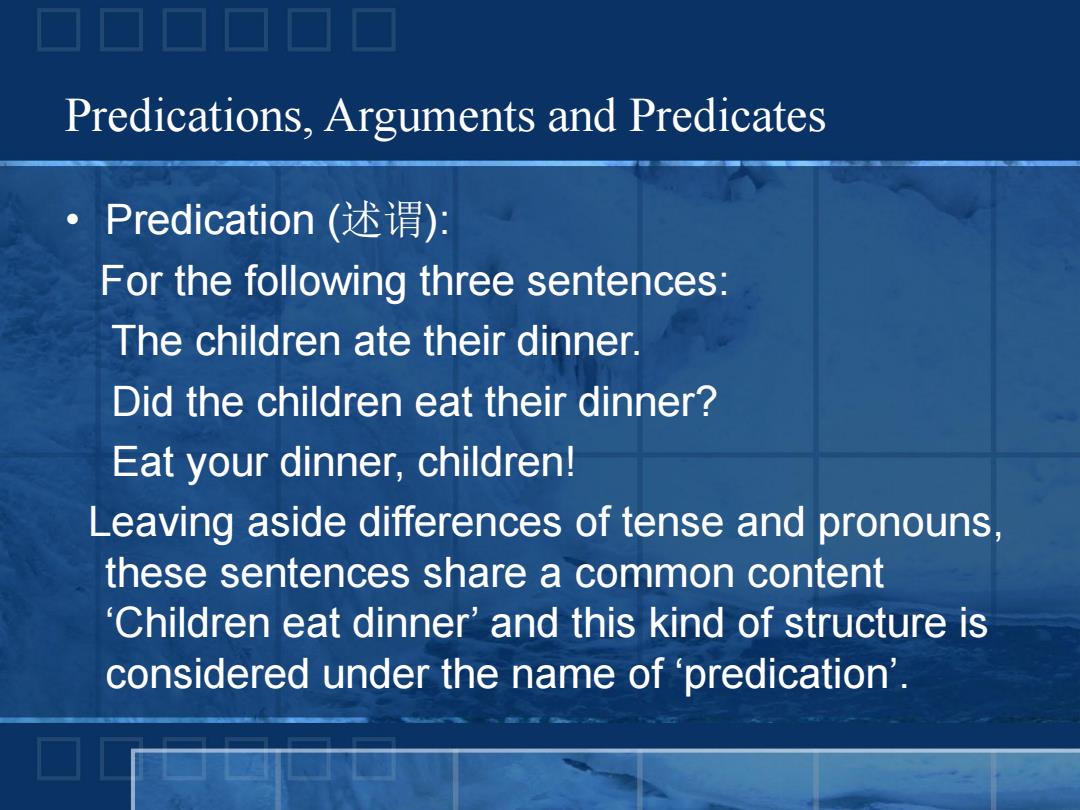
Predications,Arguments and Predicates Predication(述谓): For the following three sentences: The children ate their dinner. Did the children eat their dinner? Eat your dinner,children! Leaving aside differences of tense and pronouns, these sentences share a common content Children eat dinner'and this kind of structure is considered under the name of 'predication
Predications, Arguments and Predicates • Predication (述谓): For the following three sentences: The children ate their dinner. Did the children eat their dinner? Eat your dinner, children! Leaving aside differences of tense and pronouns, these sentences share a common content ‘Children eat dinner’ and this kind of structure is considered under the name of ‘predication’
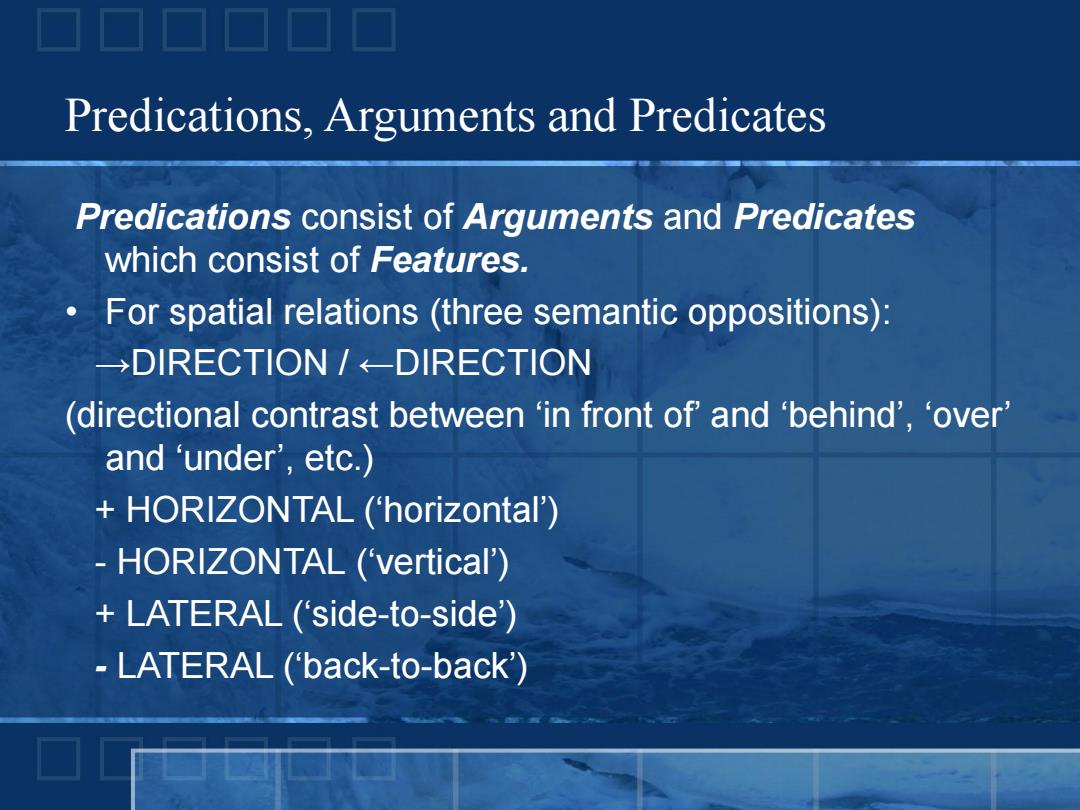
Predications,Arguments and Predicates Predications consist of Arguments and Predicates which consist of Features. For spatial relations (three semantic oppositions): →DIRECTION/←-DIRECTION (directional contrast between 'in front of'and 'behind','over' and 'under',etc.) HORIZONTAL ('horizontal') HORIZONTAL ('vertical') LATERAL ('side-to-side') LATERAL (back-to-back')
Predications consist of Arguments and Predicates which consist of Features. • For spatial relations (three semantic oppositions): →DIRECTION / ←DIRECTION (directional contrast between ‘in front of’ and ‘behind’ , ‘over’ and ‘under’ , etc.) + HORIZONTAL (‘horizontal’) - HORIZONTAL (‘vertical’) + LATERAL (‘side-to-side’) - LATERAL (‘back-to-back’) Predications, Arguments and Predicates
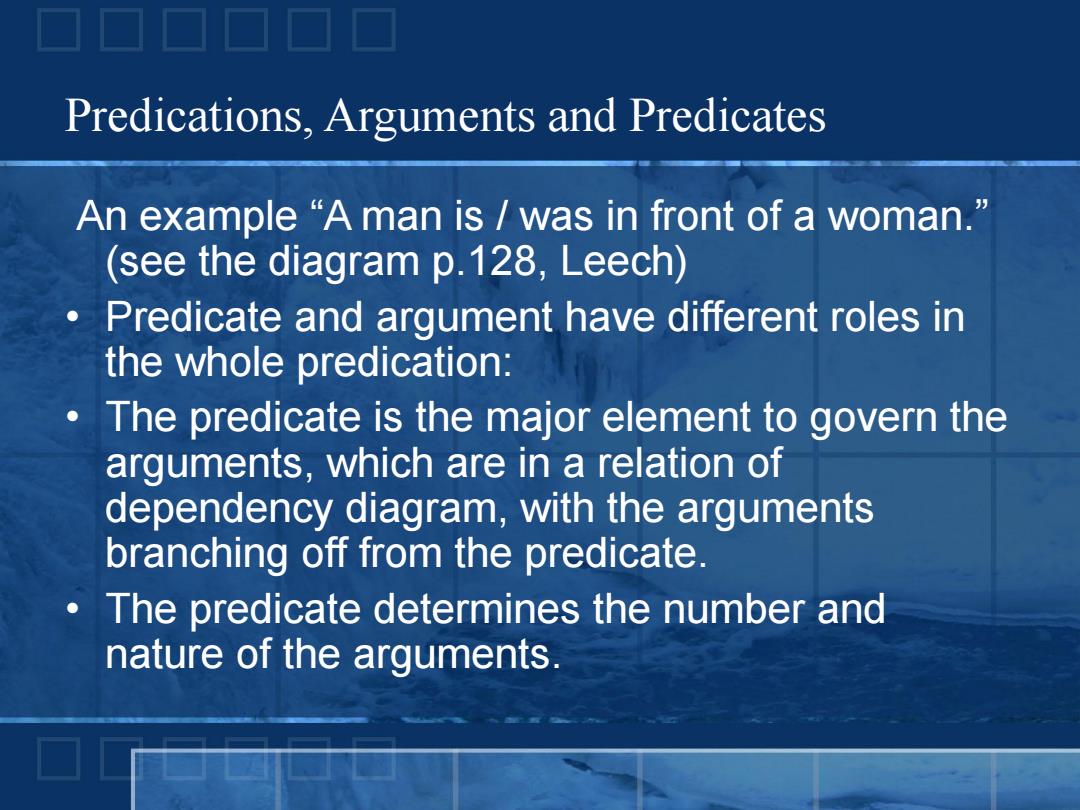
Predications,Arguments and Predicates An example "A man is was in front of a woman. (see the diagram p.128,Leech) Predicate and argument have different roles in the whole predication: The predicate is the major element to govern the arguments,which are in a relation of dependency diagram,with the arguments branching off from the predicate. The predicate determines the number and nature of the arguments
An example “A man is / was in front of a woman.” (see the diagram p.128, Leech) • Predicate and argument have different roles in the whole predication: • The predicate is the major element to govern the arguments, which are in a relation of dependency diagram, with the arguments branching off from the predicate. • The predicate determines the number and nature of the arguments. Predications, Arguments and Predicates

Predications,Arguments and Predicates The above example:the relational meaning of 'in front of requires the presence of two arguments which can be placed in a spatial relationship. One-place predicate (monadic)governs one argument (typically realized by a nominal or adjectival complement or conveyed by intransitive verbs).(see 9-11,Leech, p.130) Two-place predicate (dyadic)governs two arguments (see 8,Leech,p.129) Three-place predicate (triadic)govern three arguments (typically realized by the ditransitive verbs,combination of two-place and one-place)
• The above example: the relational meaning of ‘in front of’ requires the presence of two arguments which can be placed in a spatial relationship. • One-place predicate (monadic) governs one argument (typically realized by a nominal or adjectival complement or conveyed by intransitive verbs). (see 9—11, Leech, p.130) • Two-place predicate (dyadic) governs two arguments. (see 8, Leech, p.129) • Three-place predicate (triadic) govern three arguments (typically realized by the ditransitive verbs, combination of two-place and one-place). Predications, Arguments and Predicates
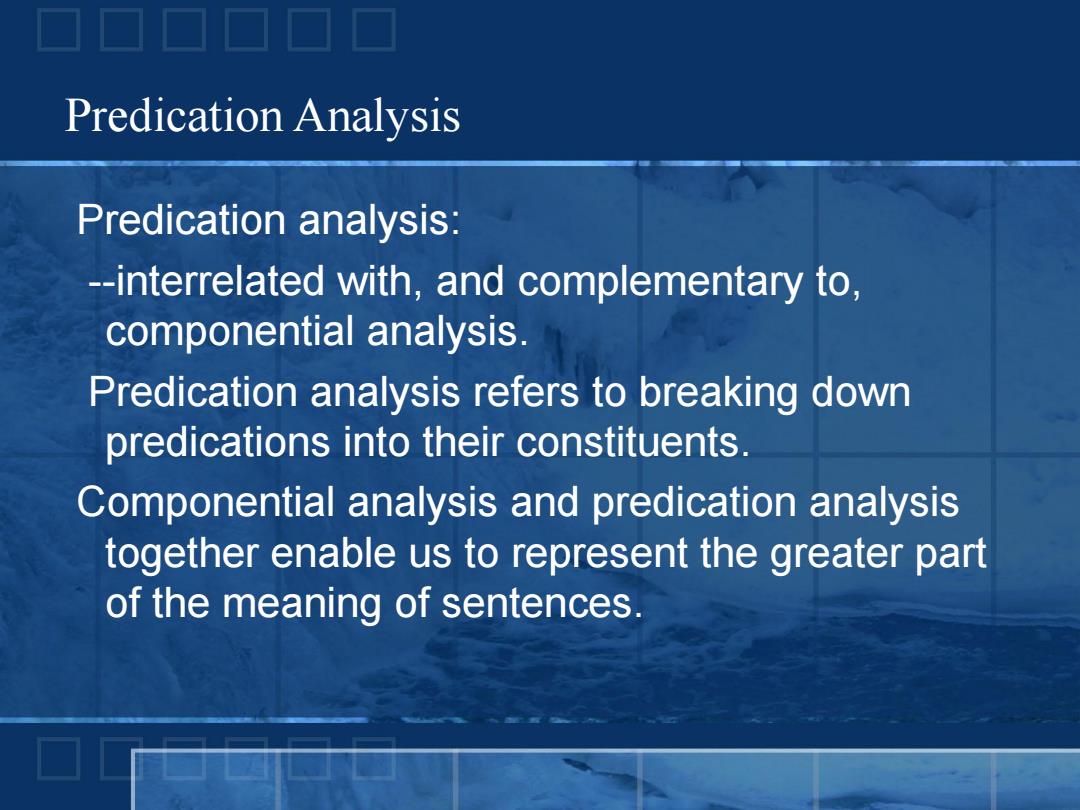
Predication Analysis Predication analysis: --interrelated with,and complementary to, componential analysis. Predication analysis refers to breaking down predications into their constituents. Componential analysis and predication analysis together enable us to represent the greater part of the meaning of sentences
Predication analysis: --interrelated with, and complementary to, componential analysis. Predication analysis refers to breaking down predications into their constituents. Componential analysis and predication analysis together enable us to represent the greater part of the meaning of sentences. Predication Analysis
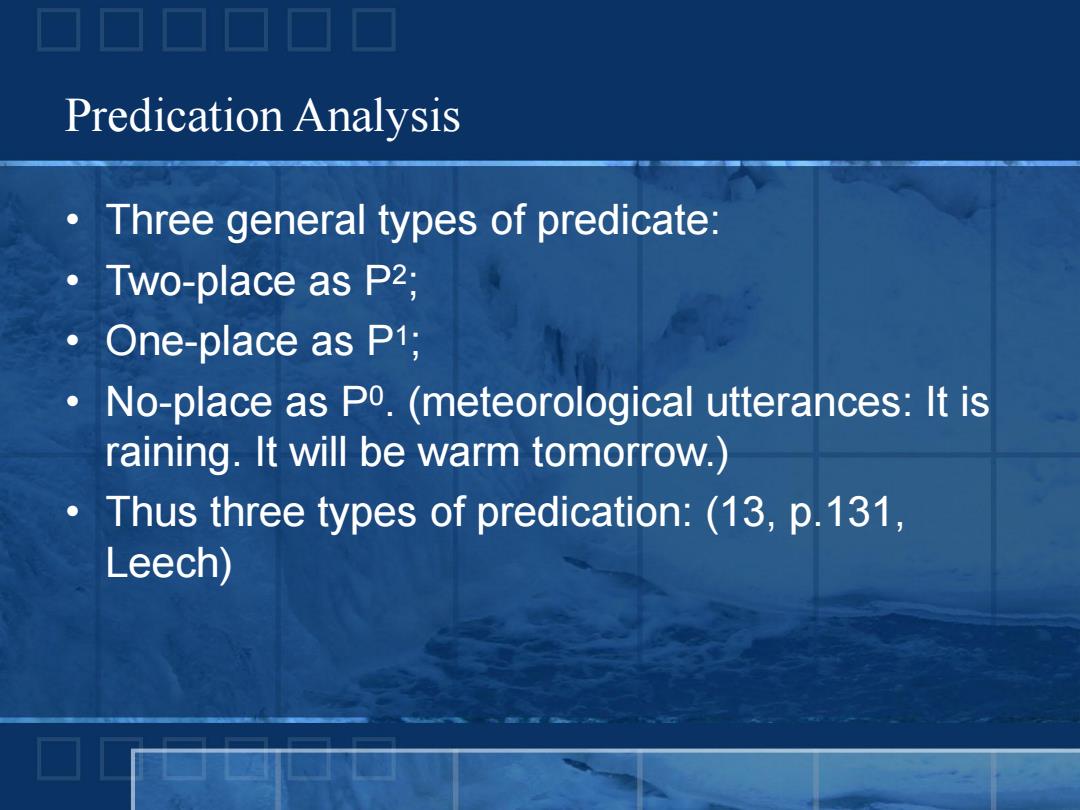
Predication Analysis Three general types of predicate: Two-place as P2; One-place as P1; No-place as Po.(meteorological utterances:It is raining.It will be warm tomorrow.) Thus three types of predication:(13,p.131, Leech)
Predication Analysis • Three general types of predicate: • Two-place as P2; • One-place as P1; • No-place as P0. (meteorological utterances: It is raining. It will be warm tomorrow.) • Thus three types of predication: (13, p.131, Leech)
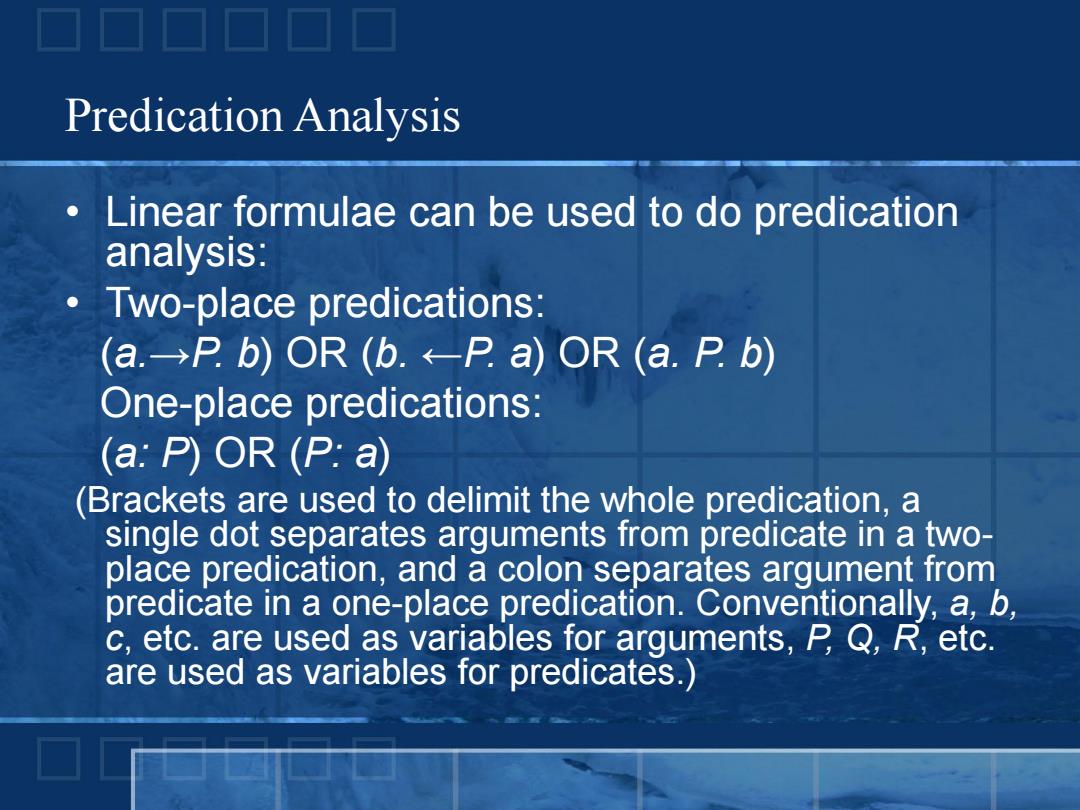
Predication Analysis Linear formulae can be used to do predication analysis: Two-place predications: (a.-P.b)OR (b.<P.a)OR (a.P.b) One-place predications: (a:P)OR (P:a) (Brackets are used to delimit the whole predication,a single dot separates arguments from predicate in a two- place predication,and a colon separates argument from predicate in a one-place predication.Conventionally,a,b, c,etc.are used as variables for arguments,P Q,R,etc. are used as variables for predicates.)
• Linear formulae can be used to do predication analysis: • Two-place predications: (a.→P. b) OR (b. ←P. a) OR (a. P. b) One-place predications: (a: P) OR (P: a) (Brackets are used to delimit the whole predication, a single dot separates arguments from predicate in a two- place predication, and a colon separates argument from predicate in a one-place predication. Conventionally, a, b, c, etc. are used as variables for arguments, P, Q, R, etc. are used as variables for predicates.) Predication Analysis

Predication Analysis 1)A predication-componential formulae:(see 7a,p.132, Leech) 2)A simple linear arrangement omitting+,↑,and→for unmarked or dominant terms: (Human Adult Male Singular.Direction-Lateral Human Adult-Male Singular) 'A man in front of a woman' (Breed-Singular:Big)'Alsatians be large 3)A mixed version: (Vehicle Singular a.P Concrete Singular b) --part of the meaning of 'The red car hit the wall
Predication Analysis 1) A predication-componential formulae: (see 7a, p.132, Leech) 2) A simple linear arrangement omitting + , ↑,and → for unmarked or dominant terms: (Human Adult Male Singular . Direction –Lateral . Human Adult –Male Singular) ‘A man in front of a woman’ (Breed –Singular: Big) ‘Alsatians be large’ 3) A mixed version: (Vehicle Singular a. P. Concrete Singular b) --part of the meaning of ‘The red car hit the wall’